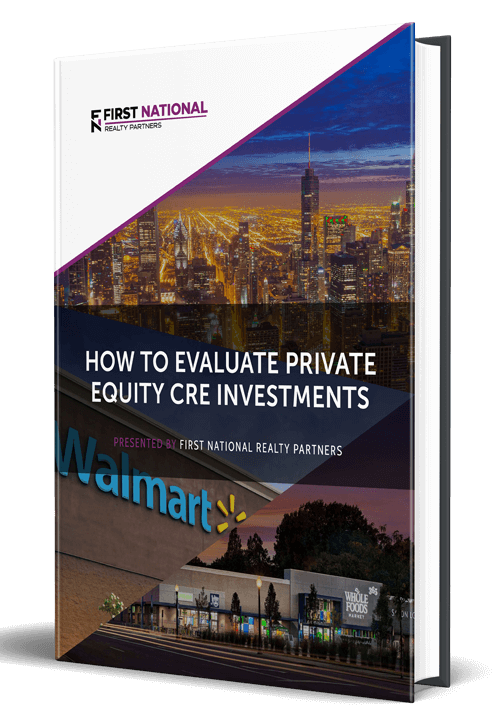In any sort of investment, diversification is a bedrock risk management principle. The idea behind it is to spread investment capital over a variety of uncorrelated asset classes to mitigate the impact of declines in any one of them. For example, the prices of stocks and bonds tend to move in opposite directions so it makes sense to invest some money in each of them. This way, when the prices for one asset are going down, the price for the other asset is going up so the resulting increase offsets the decline.
As professional real estate investors, we believe that commercial real estate assets deserve an allocation in a broadly diversified portfolio of risk assets. The exact allocation is up to each individual investor, but a well-diversified portfolio typically includes some amount of stocks, bonds, commercial real estate, and commodities. Within each one of these asset classes, there are opportunities for further diversification. The intent of this article is to review the diversification options available when investing in commercial real estate.
How to Diversify A Commercial Real Estate Investment Portfolio
Within the world of commercial real estate investing, there are four widely recognized methods for achieving a diversified investment portfolio.
Method #1: Diversification Through Multiple Transaction Sponsors
For individuals seeking passive income through commercial property investment, the most logical course of action is to place their money with a transaction sponsor who manages both the investment logistics and the investment property itself. This can be a very effective strategy, but not all commercial real estate sponsors are the same. They may pursue different real estate investment strategies, have different management philosophies, and charge different fee amounts. For this reason, their performance can vary widely.
So, if an investor has a certain amount of capital to commit to an investment, it can be a good idea to diversify it among several different transaction sponsors. For example, if an individual has $100,000 total to invest, it may be a better idea to give $25,000 each to four different transaction sponsors rather than $100,000 to one.
Method #2: Diversification Through Multiple Types of Real Estate
There are four widely recognized commercial investment property types:
- Office: Office space is designed for the unique needs of running a business. Office space can be general, meant to cater to companies like accounting and law firms. Or, it could be designed to meet the unique needs of a specialized type of tenant, like a doctor’s office. Office investors benefit from long term leases and generally low tenant turnover because it is difficult and often expensive to move a business. But, those same leases may come with infrequent rental increases and expensive tenant improvements to entice a company to move in.
- Industrial: An industrial property is one with a purpose that is industrial in nature, and may include standalone warehouses, logistics facilities, or “flex” spaces. Industrial investors benefit from predictable cash flow, lower operational risks, low CapEx requirements, and generally favorable supply/demand characteristics. However, industrial spaces can be especially vulnerable to economic disruptions and may have high upfront costs due to their large physical footprints.
- Retail: Retail properties are designed for tenants who operate direct-to-consumer (DTC) businesses, like clothing or electronics stores. Classic examples of retail properties include strip malls, shopping centers, and standalone bank branches. Retail investors benefit from high visibility and long-term tenant leases. But, the financial strength of tenants can be impacted by changing market tastes, and the interior of a retail property is often built for a specific purpose, making the property difficult and often expensive to re-lease without major renovations.
- Multifamily: A commercial multifamily property is one with five or more residential units. Multifamily investors benefit from relative stability in economic downturns, but they may face challenges with high tenant turnover, short-term leases, and increased collection expenses.
From the descriptions above, it’s clear that there are benefits and risks to investing in each real estate property type, so another possible diversification strategy is to spread money across some or all of them. This works well because transaction sponsors often specialize in one specific property type (for example, we specialize in retail properties). Continuing the example from above, an individual could place $25,000 with one sponsor who specializes in multifamily apartment buildings, $25,000 with one who specializes in office buildings, and so on.
Method #3: Diversification Through Multiple Property Classes
Likewise, there are four widely recognized property “classes” each of which represents an investment’s risk profile:
- Class A: Class A buildings are the newest and highest quality. They tend to be less than ten years old and are typically located in or near the Central Business Districts and/or most desirable locations of major cities (such as in New York City). Class A properties are the least risky and generally offer the most stable returns.
- Class B: Class B buildings are well-maintained, but may be slightly dated and in need of light renovations. They are usually between 10 and 20 years old and typically located in good, but not great markets. Given their age and slightly inferior location, they carry more risk than Class A properties, but also offer a potentially higher return on investment
- Class C: Class C buildings are an older vintage, often dated, and in need of moderate to significant repairs. They are between 20 and 30 years old and are typically located in less desirable areas that are far from major highways, shopping districts, employment centers, and public transportation. Class C properties are the next step up on the risk/return spectrum. They can offer high returns that consist of income and growth. But they can also be variable from year to year.
- Class D: Class D properties are distressed assets. They are economically and/or functionally obsolete and require major investments to get them back to market standards. In terms of potential returns, they represent a classic boom/bust scenario where there is a high degree of volatility in returns. Successful investments can deliver fantastic returns. Unsuccessful investments can result in a total loss of capital.
Again, it can make sense to diversify a portfolio through investment in different property classes. Often, investors like to have Class A/B holdings comprise the core of their portfolio, but add some Class C for its growth opportunities.
Method #4: Diversification Through Locations
Unlike the stock market or bond market, the success of a real estate investment opportunity is heavily influenced by the real estate market in which the asset is located. For this reason, it can make sense to spread investment capital over multiple locations. For example, $25,000 could be committed to a property in a stable location like New York City, while another $25,000 could be committed to a high growth location like Miami.
Conclusions and Summary
Diversification is one of the most important risk management tools in a CRE investment portfolio. Proper diversification can help boost overall returns and limit downside risk. For investors interested in diversifying their real estate portfolio, there are four primary ways in which it can be done: transaction sponsor, property/asset type, property class, and location.
By considering each of the above elements of commercial real estate investment portfolio diversification, investors can feel safer knowing that they have reduced their overall risk of their investment.
Interested In Learning More?
First National Realty Partners is one of the country’s leading private equity commercial real estate investment firms. We leverage our decades of expertise and our available liquidity to find world-class, multi-tenanted assets below intrinsic value. In doing so, we seek to create superior long-term, risk-adjusted returns for our investors while creating strong economic assets for the communities we invest in.
If you are an Accredited Investor and would like to learn more about our investment opportunities, contact us at (800) 605-4966 or info@fnrpusa.com for more information.






